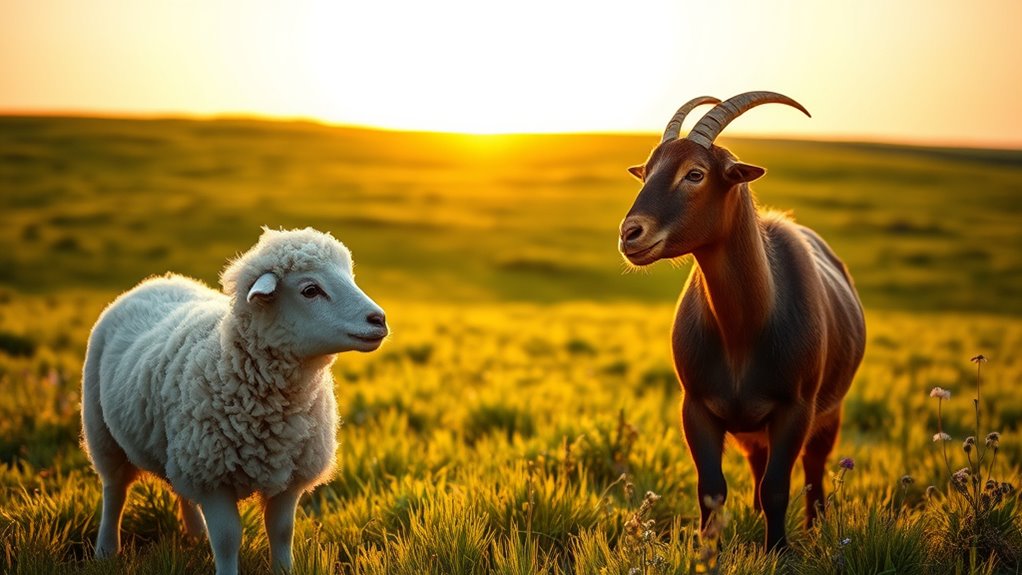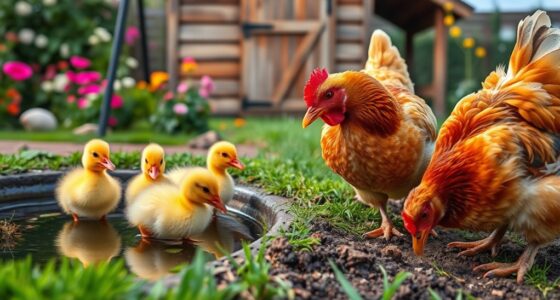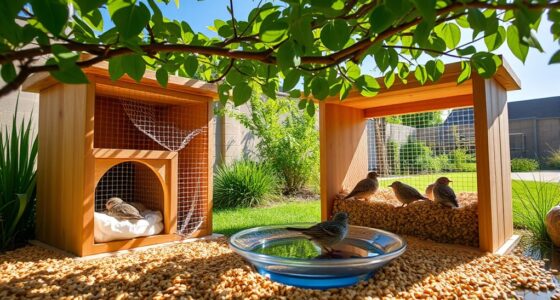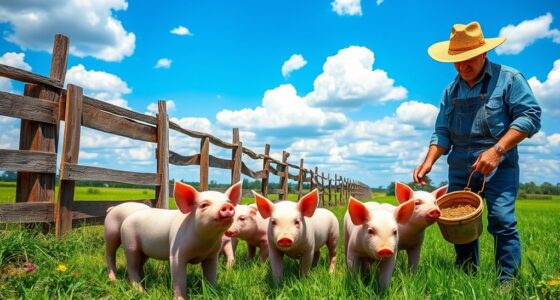Sheep and goats can't breed due to their significant genetic differences—sheep have 54 chromosomes while goats have 60. This chromosomal mismatch creates barriers to hybridization, resulting in most hybrids being sterile, especially males. Even female hybrids often face fertility challenges. While rare cases of hybrids exist, they typically show mixed traits and limited reproductive success. If you're curious about the complexities of keeping these animals together, there's much more to explore.
Key Takeaways
- Sheep and goats cannot breed successfully due to significant genetic differences, with sheep having 54 chromosomes and goats having 60.
- Hybrids, when they occur, typically have an intermediate chromosome count of 57 but face sterility issues, especially in males.
- Most hybrids are stillborn due to chromosomal incompatibility, with few surviving to adulthood.
- Female hybrids may retain some fertility but often experience reduced reproductive success due to genetic mismatches.
- Coexistence in farming is possible, but managing mixed flocks can be challenging due to behavioral differences and dietary needs.
Genetic Compatibility Between Sheep and Goats
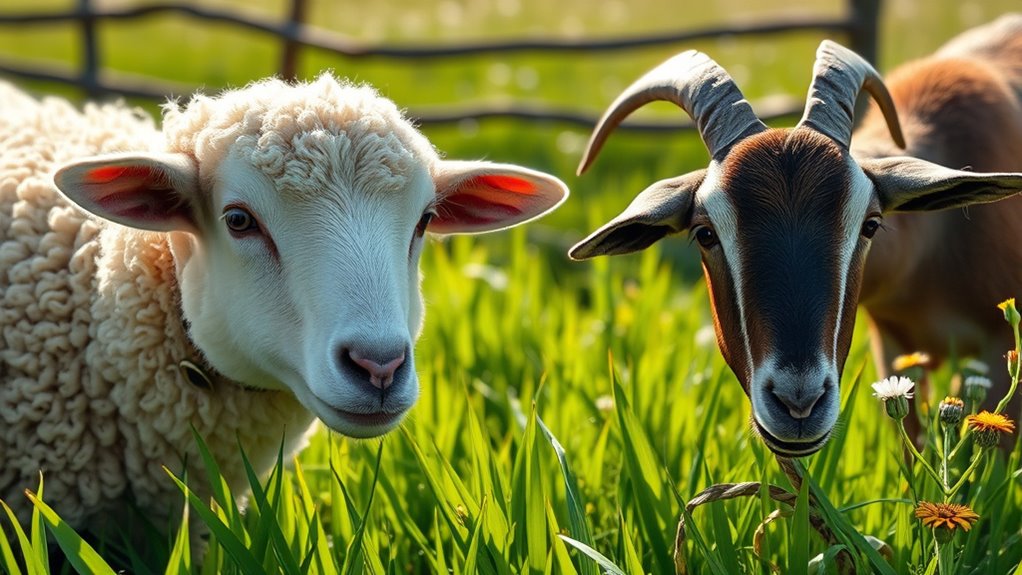
Although sheep and goats share the same family, Bovidae, their genetic compatibility is limited due to significant differences in chromosome numbers and genetic makeup. Sheep have 54 chromosomes, while goats possess 60, creating barriers to successful hybridization.
Despite sharing many genes, including those related to prion proteins, the genetic distance between them is considerable. This difference complicates meiosis in hybrids, often resulting in stillbirths. Most hybrid males are sterile, aligning with Haldane's rule, which affects many interspecies hybrids.
Female hybrids might face reduced fertility due to chromosomal mismatches. Ultimately, these genetic differences illustrate why breeding between sheep and goats is rare and often unsuccessful, underscoring the importance of understanding their distinct genetic profiles.
Reproductive Challenges and Processes

Understanding the reproductive challenges and processes in sheep and goats is essential for anyone involved in their care and management. Reproductive cycles often align with annual production, making effective management crucial for animal welfare and optimal yields.
Various practices, like feed flushing, can significantly enhance breeding success and milk production. However, environmental factors, such as photoperiods and thermal stress, can negatively impact reproductive performance. Nutritional deficiencies, particularly in minerals, also play a vital role in reproductive health.
Furthermore, infectious diseases pose significant threats, complicating health management. To improve reproductive outcomes, focus on selecting high-quality breeding animals and maintaining proper nutrition and health protocols. Addressing these challenges can lead to better productivity and economic viability in sheep and goat farming.
Characteristics of Sheep-Goat Hybrids

Sheep-goat hybrids exhibit a fascinating blend of characteristics that reflect their unique genetic makeup.
You'll notice they typically have the body of a sheep but the head of a goat. Their longer legs give them an agile appearance, while their coat features a coarse outer layer combined with a woolly inner coat. Most hybrids inherit goat-like horns.
With an intermediate chromosome count of 57, these hybrids display significant genetic variation, often showing traits from both parents. They're generally heavier and more robust than either species, boasting greater stamina.
While hybrids can produce milk and high-quality wool, their sterility limits breeding. Despite this, they can serve as strong working animals, showcasing impressive growth rates and muscling traits.
Coexistence and Management in Farming
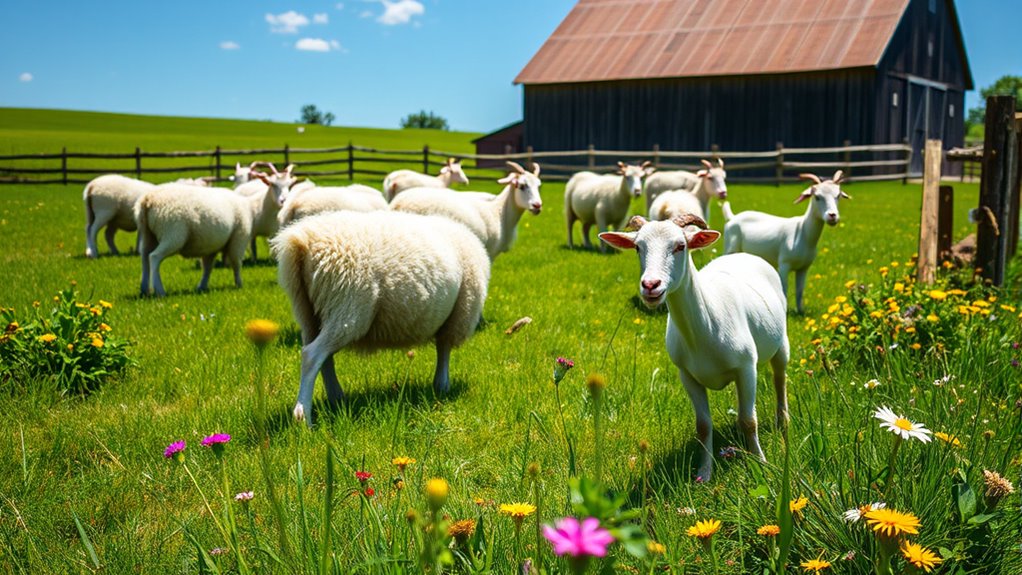
When you manage a mixed flock of sheep and goats, you'll find that their coexistence can present both challenges and rewards. Both species share dietary similarities, primarily grazing on forages, but housing them together can be tricky due to their different behaviors and sizes.
You'll need to consider individual personalities, as some goats can be aggressive, especially horned ones, posing risks to sheep. Ensure your land is suitable; goats thrive in brushy areas, while sheep prefer pasture.
Effective grazing practices can lower feed costs and improve sustainability. Don't forget about health management, as parasites can affect both species.
Rare Cases and Observations of Hybrids

Although hybridization between sheep and goats is rare due to their genetic differences, some fascinating cases have emerged that challenge our understanding of interspecies reproduction. Documented instances of live births have occurred in places like Ireland and the USA, showcasing the global nature of these hybrids.
Most hybrids are stillborn because of chromosomal incompatibility, but those that survive often have an intermediate chromosome count, typically 57. This can lead to mixed physical traits and fertility issues.
While male hybrids are usually sterile, females may retain some fertility, with occasional successful backcrossing to rams. Despite their rarity, these hybrids illuminate the complexities of genetic compatibility and raise ethical considerations regarding their breeding and care.
Frequently Asked Questions
What Are the Behavioral Differences Between Sheep and Goats?
When you observe sheep and goats, you'll notice distinct behavioral differences.
Sheep tend to flock together, relying on their strong instinct for safety. In contrast, goats are more independent and curious, often exploring their surroundings.
While sheep stay close for comfort, goats scatter when threatened, using their agility to escape.
Additionally, goats require space to climb and roam, whereas sheep thrive in managed pastures, focusing on grazing together.
How Do Sheep and Goats Communicate With Each Other?
When sheep and goats chat, they've got their special ways.
You'll notice the body language, with postures and expressions speaking volumes. They'll vocalize too; goats have their distinct calls while sheep prefer their gentle bleats.
Sometimes, they'll engage in a friendly head-butt or rub against one another, showing camaraderie.
Don't forget the scents they share, which convey important messages about their moods and intentions.
It's a fascinating world of communication!
Can Sheep and Goats Be Kept Together Safely?
You can keep sheep and goats together safely, but it requires careful management.
Ensure they've enough space and separate feeding areas since their dietary needs differ.
Monitor their interactions, as goats can be more aggressive.
Providing secure fencing is essential to protect against predators.
Additionally, regular health checks will help maintain their well-being, benefiting both species.
With proper precautions, you can create a harmonious environment for your livestock.
What Are the Nutritional Needs of Sheep Versus Goats?
You might think sheep and goats have identical nutritional needs, but they don't.
Sheep primarily graze on grasses and legumes, while goats prefer browsing on shrubs and trees. Both require quality forage, but goats need more copper in their diets.
When you consider their life stages, remember that pregnant or lactating animals need extra protein and energy. Ensuring you meet these specific needs keeps your flock healthy and thriving.
How Do Sheep and Goats Handle Extreme Weather Conditions?
When it comes to handling extreme weather, you'll notice that sheep and goats adapt in various ways.
They seek shade, adjust grazing times, and increase their water intake to stay cool.
Sheep may rely more on their wool for insulation, while goats might utilize their agility to find shelter.
Both animals can exhibit changes in behavior, like resting during the hottest parts of the day, ensuring they stay comfortable despite harsh conditions.
Conclusion
In conclusion, while sheep and goats can't typically breed due to genetic incompatibility, their fascinating coexistence in farming offers unique benefits. Did you know that nearly 60% of farms in the U.S. raise both sheep and goats? This not only enhances biodiversity but also creates a balanced ecosystem. So, even though hybrids are rare, the relationship between these two species is undeniably valuable in agriculture. Embracing their differences can lead to a thriving farm environment.

